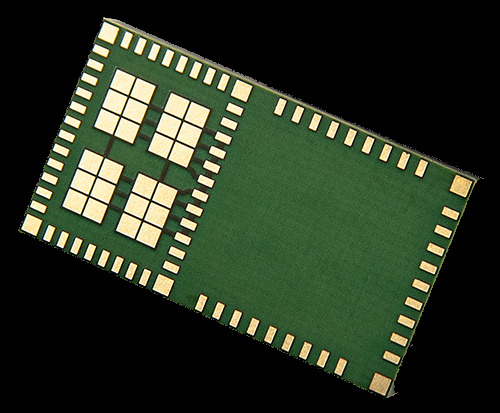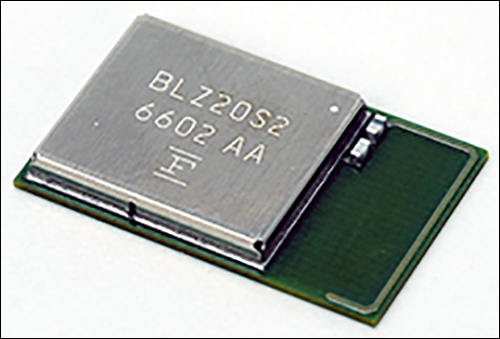Presented here are news announcements made during the past week by the following organizations:
the RAIN RFID Alliance;
Know Labs;
Insight SiP;
Murata Manufacturing, Cypress Semiconductor, NXP Semiconductors;
Fujitsu Components America, Nordic Semiconductor;
Litmus Automation, and Siemens.
RAIN RFID Alliance Reports 15 Billion RFID Tag Chips Sold in 2018
The RAIN RFID Alliance has announced that 15.4 billion RFID tag chips were sold last year. This represents a 23 percent growth over the total sold for 2017, the organization reports, and the RFID market is on track to more than 20 billion tag chips sold annually for 2020 and beyond.
The Alliance collects volume data from RFID tag chip manufacturers that are members of the organization. These members, including Alien Technology, Axzon, EM Microelectronic, Impinj and NXP Semiconductors, sold 15.4 billion tag chips in 2018.
“RAIN is the preeminent identifying technology for the Internet of Things (IoT), and last year RAIN technology enabled over 15 billion things to be connected to the IoT,” said Steve Halliday, the president of the RAIN RFID Alliance, in a prepared statement. “We have daily discussions with members of the Alliance, currently over 160 worldwide, and it is exciting to hear about the growing number of RAIN solutions to tag ‘things’ across many markets.”
The markets using RAIN RFID include aviation, electronics, food, health care, logistics, manufacturing, packaging and retail. Tags can be attached or embedded; flexible or hardened; basic identification numbers or more memory and data; used for long-range or short-range; alone or connected to sensors, such as temperature or pressure; or without batteries or battery-assisted.
Know Labs RFID Platform Identifies Blood-Alcohol Levels
Know Labs, a provider of diagnostic solutions, has released a video presentation of its Bio-RFID platform’s ability to identify blood-alcohol levels. In the video presentation, Phil Bosua, Know Labs’s CEO, discusses the company’s use of Bio-RFID to detect blood-alcohol levels, as well as the broad implications for its technology platform.
A transcript of Bosua’s presentation in the video states, in part: “Over the last month, we’ve been powering through a ton of experiments and innovations and are really happy to report we’ve now got an AI-based algorithm that allows our technology to detect blood-alcohol levels non-invasively. So it’s official: Bio-RFID is now a platform technology. Not only can we detect the Holy Grail of biotech—blood glucose—but also blood alcohol, and more to come in the future… You’re witnessing a technology emerge that will change personal medicine forever. And we have even bigger plans for this that we hope will transform early warning medical diagnosis”
Click here to view the video.
Insight SiP Launches BLE-enabled LoRa RF Modules
Following the prior launch of its Bluetooth Low Energy (BLE) modules, Insight SiP, a provider of ultra-miniature RF modules, is unveiling its ISP4520 modules, thereby extending its product portfolio to include long-range networking via LoRa technology. The ISP4520 module integrates BLE and LoRa radio functionality, combining short-range, high-throughput capability with smartphone/PC access to BLE and the long-range features of LoRa technology. The module uses Insight SiP’s patented antenna-in-package technology with its system-in-package design approach to embed BLE and LoRa antennas into a single device measuring 9.8 millimeters by 17.2 millimeters by 1.7 millimeters.
LoRa technology offers a wide-area networking solution for Internet of Things (IoT) applications, typically in use cases requiring a limited data rate and long-term battery-powered operation. LoRa can operate via public networks and in a private network scenario. BLE offers a higher bandwidth channel for the device, which can be used for commissioning, software updates or maintenance, as well as for connecting local sensors to a central hub.

The BLE part of the ISP4520 integrates the WLCSP nRF52832 chip from Nordic Semiconductor and employs the design of Insight SiP’s existing BLE product range. It comes with integrated 32 MHz or 32 KHz crystals, an RF antenna, and a matching circuit and DC-DC convertor. The ISP4520 device includes an ARM Cortex M4F processor with 512 KB of Flash memory and 64 KB of RAM. A set of interfaces is supplied for analog or digital peripherals, including 30 GPIOs, an analog-to-digital convertor, and SPI, I2C and UART buses. It also provides NFC connectivity for easy pairing.
“We’re delighted to offer the ISP4520 to customers who want to integrate a high quality, low cost, ultra-miniature RF module into their products,” said Nick Wood, Insight SiP’s president, in a prepared statement. “The launch of this module represents a major extension of our product range with an Insight SiP quality solution for the wide area networking domain. We are proud to demonstrate this latest step forward for our unique Antenna in Package technology.”
The module can operate on wide-area networks and is compatible with the LoRaWAN open standard developed by the LoRa Alliance. The module runs Nordic’s Bluetooth soft device, which supports a Bluetooth V4.2 stack and is Bluetooth 5.0-ready. Module prototypes are available now, and mass production of the modules is slated to begin during the second quarter of this year, with certification pending. Insight SiP offers a development kit together with sample software.
Murata, Cypress, NXP Collaborate on Multi-Platform Wi-Fi IoT Solutions
Murata Manufacturing has announced that it is collaborating with Cypress Semiconductor and NXP Semiconductors to provide Internet of Things (IoT) developers with wireless connectivity and processing solutions. The combined products pair Murata’s wireless modules, based on Cypress’s Wi-Fi and Bluetooth combos, with a range of processors from NXP’s i.MX series.
“IoT customers still face significant design challenges in getting their connected products to market,” said Toshifumi Oida, the director of Murata’s communications module division, in a prepared statement. “This collaborative effort solves that challenge while enabling a broad range of new applications. Together with Cypress and NXP, we are providing out-of-box solutions with a wide range of i.MX processors and connectivity options to fit any IoT systems’ application requirements.”
The solutions give developers a range of scalable processing platforms, including i.MX 6, i.MX 7 and i.MX 8 Series application processors and i.MX RT crossover processors. The Wi-Fi/Bluetooth connectivity solutions include 1×1 802.11bgn, 802.11abgn and 802.11ac up to 2×2 802.11ac, as well as Bluetooth 5.0 support. Murata worked with Cypress and NXP to ensure that the hardware platform and corresponding software would be validated for a streamlined experience. Customers have direct access to the necessary software in NXP’s Linux board support package and MCUXpresso SDK.
“In order to address the vast breadth of applications that make up the IoT, Cypress takes the approach of giving customers flexibility for processing options to pair with our Wi-Fi and Bluetooth combo solutions,” said Michael Hogan, the senior VP of Cypress’s IoT Compute and Wireless Business Unit, in a prepared statement. “We are giving developers of the diverse range of products served by the i.MX processor family the ability to provide the robust connectivity user experience that people expect, while cutting time to market.”
“From our experience working with a vast customer base, we know a key pain point is Wi-Fi integration and certification,” said Martyn Humphries, NXP’s VP and general manager for i.MX applications processors, in the prepared statement. “From a platform perspective, our collaboration with Murata and Cypress addresses this need, providing a simplified, system-level solution that is fully validated. Our partnership with Murata provides customers with a full range of Wi-Fi solutions with our i.MX evaluation kits for thousands of applications across Industrial, Automotive and IoT.”
Fujitsu Intros New BLE Wireless Modules
Fujitsu Components America has released its FWM7BLZ20B Bluetooth 5.0 Low Energy wireless modules. The new modules are designed to meet the high communication speed requirements of Internet of Things (IoT) devices and applications.
The FWM7BLZ20B series is powered by Nordic Semiconductor‘s nRF52832 system-on-chip (SoC) and features lower power consumption than classic Bluetooth (BR/EDR), increased communication speed (X2 speed), 255 bytes of LE advertising extensions and other expansions to Bluetooth 4.x. The symbol and data rates accommodate 1Mbps and improved 2Mbps to facilitate communication speed with other Bluetooth devices, according to the company.

The series includes two models. The FWM7BLZ20B module contains Fujitsu’s embedded firmware, enabling Bluetooth protocol stack handling by simple text commands via UART. It features a GATT Direct Access Function, which enables access with other modules through the GATT layer commands. With this function, host equipment can communicate simultaneously with up to eight peripherals. It also facilitates communication with other manufacturers’ Bluetooth modules.
The FWM7BLZ20B-109077 is a blank module without Fujitsu firmware. Users can develop unique firmware, including X2 speed and LE advertising extension using tools provided by Nordic Semiconductor. This module includes embedded NFC support function to pair with NFC-embedded devices via external antenna. Samples are available now.
Litmus Automation Partners With Siemens on IoT Edge-Computing Solutions for Manufacturing
Litmus Automation, an Industrial Internet of Things (IIoT) platform provider, has announced that it has joined the MindSphere Partner Program, a Siemens partner program for IIoT solution and technology providers. Litmus’s LoopEdge platform, available immediately, collects data from industrial devices and makes it available on MindSphere, a cloud-based open IoT operating system from Siemens.
Litmus Automation’s LoopEdge platform provides the ability to connect to any type of PLC or industrial system, with the ability to process, filter and analyze data at the edge with a marketplace of applications, and secure connectivity to the cloud or other enterprise integrations. LoopEdge has the ability to integrate data with MindSphere in real time via a simple interface. In addition to LoopEdge, Litmus Automation also offers its users the Loop solution, which enables data manipulation via built-in analytics and real-time visualization, and for the management of any connected hardware, device, sensor or machine, the company reports.
“Siemens is committed to creating partnerships that help customers digitally transform with Industrial IoT,” said Paul Kaeley, Siemens PLM Software’s senior VP for global partner ecosystems, in a prepared statement. “Working with Litmus Automation allows us to bring powerful edge computing to the MindSphere ecosystem to improve customers’ ability to gather valuable data from the edge and use it to improve manufacturing processes.”
MindSphere connects products, plants, systems and machines, enabling businesses to harness the wealth of data generated by the IoT with advanced analytics. Litmus’s LoopEdge platform, integrated with MindSphere, is available immediately and targets OEMs and customers in manufacturing, power distribution, and machine building.
“Our partnership with Siemens enables us to help more customers solve their IoT challenges including legacy device integration, device lifecycle management, and advanced edge computing capabilities,” said John Younes, Litmus Automation’s co-founder and COO, in the prepared statement. “Customers now have a powerful edge computing solution to collect data from all of their industrial devices and make it available on MindSphere in a quick and easy way.”

